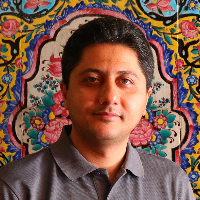Recognizing the Design & Layout of the Lost Tileworks of the Eastern Wall of Shiraz’s Karim-khan Citadel (Arg)
Author(s):
Article Type:
Research/Original Article (دارای رتبه معتبر)
Abstract:
Zandieh is a short period in Iranian history (1751-1794 AD) which influence on Qajar art (1794-1925 AD) has always been discussed. The period of Karim-Khan Zand (1751-1779 A.D) is considered as one of the three stages of the evolution and development of Iranian art after the fall of the Safavids, which is a combination of a kind of "realism" and "ancientism," but both in the folk tradition, with the suspension fluctuated between the return to royal traditions and the pursuit of European arts. However, Zandieh-era tileworks have not been sufficiently investigated. Tileworks in Zand dynasty are limited, and at the same time, the Arg or Citadel of the Karim-Khan Zand is also considered to be most widely made of bricks, which has few tileworks. Much of the research in this area has focused on brick ornamentation and paintings. Therefore, case studies in identifying each part of the original Zandieh-era tilework can be useful in seeking a comprehensive understanding of Zand art. The current research could be evaluated in this context. Except for a number of mosaics and arabesque motifs in tileworks, there were three lost tileworks located at the entrance to the Arg in the courtyard at the Eastern side, which have been lost for decades and for some unknown reasons. The middle tilework is larger and its shape is a square with an approximate size of 2.70 m. The two northern and southern tileworks have similar proportions and an approximate size of 1.70 at 2.70 m. The geometric analysis of the components of these three tiles reflects the pivotal geometry of the motifs. Each of these three constituents has only a relative axial symmetry and is, at the same time, in perfect alignment with the central tile of the largest size. The purpose of the current research is to recognize the "scheme" and the "content" of these tileworks, and to study similar examples and their impact on the correct understanding of the geometry and architecture of the citadel. The research method is an interpretive-historical approach that uses analytical and deductive data such as historical photographs, field observations, writings by historians and tourists. In the first step, by studying the artistic features of the Zandieh-era works, the basic principles necessary for understanding the notions of Zand art are underlined, with emphasis on tile paintings. In the second step, after the dating of the tilework, its design has been compared to similar examples and its content has been adapted to the Zand art history. At the end and in the third step, analyzing its composition, its role in the spatial structure of the citadel in a descriptive-analytical approach is discussed. The findings of this study showed that these tileworks are a reflection of the ordinary architecture of the Arg; the representational content of these three tileworks shows the presence of servants with floral dresses, long clothes and small hats that represent Zand's traditional dress and serve with numerous dishes of fruit, cup and pitcher. The natural landscape, in contrast to the steady state of the Arg, represents the dynamic nature and the life of the citadel. Due to reasons such as lack of sufficient land for construction, the complexity of the functions resulting from the creation of a residential space along with the service sectors such as the bath and the spaces of servants and need for security, the Arg developed a simple courtyard house to fit within the shape of an inland city citadel. The aesthetics of the plan are based on the four-Ivan pattern of the Safavid era, and the combination of the two scales of the house and the citadel have led to the removal of the Ivan of the eastern side for a variety of reasons. This fault has been retrieved by the imitation of the Arg architecture (including the two-column Ivan, the upper niche of the two-chambered rooms, the paintings with the flower pattern, etc.), and in particular the representation of the main Ivan (the king's), a two-dimensional image of the Ivan and its components have compensated the architectural defects. The geometric analysis of the constituents of these three tileworks shows the remarkable geometry in the layout of the motifs. Each of the three alone has relative axial symmetry and is in complete symmetry with the large central tile. In addition to their artistic and aesthetic role in creating diversity on the inner eastern wall of the Arg and creating the focal point of the longitudinal axis of the Arg from the Ivan to the entrance, the following could also be pointed out: a) Tileworks as a reflection of the daily servants of the Arg; (b) Tileworks as a two-dimensional mirror against the architectural three-dimensional elements; (c) Tileworks as an ideal world against the real world of Arg; and (d) Tileworks as aesthetic concept of Qajar local governors in the administrative buildings and houses.
Keywords:
Language:
Persian
Published:
Negareh journal, Volume:15 Issue: 55, 2020
Pages:
87 to 99
magiran.com/p2226460
دانلود و مطالعه متن این مقاله با یکی از روشهای زیر امکان پذیر است:
اشتراک شخصی
با عضویت و پرداخت آنلاین حق اشتراک یکساله به مبلغ 1,390,000ريال میتوانید 70 عنوان مطلب دانلود کنید!
اشتراک سازمانی
به کتابخانه دانشگاه یا محل کار خود پیشنهاد کنید تا اشتراک سازمانی این پایگاه را برای دسترسی نامحدود همه کاربران به متن مطالب تهیه نمایند!
توجه!
- حق عضویت دریافتی صرف حمایت از نشریات عضو و نگهداری، تکمیل و توسعه مگیران میشود.
- پرداخت حق اشتراک و دانلود مقالات اجازه بازنشر آن در سایر رسانههای چاپی و دیجیتال را به کاربر نمیدهد.
In order to view content subscription is required
Personal subscription
Subscribe magiran.com for 70 € euros via PayPal and download 70 articles during a year.
Organization subscription
Please contact us to subscribe your university or library for unlimited access!



